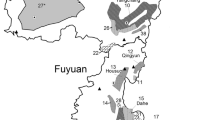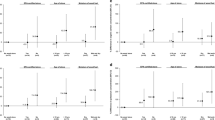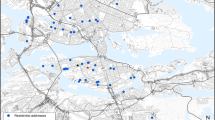Abstract
Background
Little is known about sources of residential exposure to carbonaceous aerosols, which include black carbon (BC), the elemental carbon core of combustion particles, and organic compounds from biomass combustion (delta carbon).
Objective
Assess the impact of residential characteristics on indoor BC and delta carbon when known sources of combustion (e.g., smoking) are minimized.
Methods
Between November 2012-December 2014, 125 subjects (129 homes) in Northeast USA were recruited and completed a residential characteristics questionnaire. Every 3 months, participants received an automated sampler to measure fine particulate matter (PM2.5) in their home during a weeklong period (N = 371 indoor air samples) and were also questioned about indoor exposures. The samples were analyzed using a transmissometer at 880 nm (reflecting BC) and at 370 nm. The difference between the two wavelengths estimates delta carbon. Outdoor BC and delta carbon were measured using a central site aethalometer.
Results
Geometric mean indoor concentrations of BC and delta carbon (0.65 µg/m³ and 0.19 µg/m³, respectively), were greater than central site concentrations (0.53 µg/m³ and 0.02 µg/m³, respectively). Multivariable analysis showed that greater indoor concentrations of BC were associated with infrequent candle use, multi-family homes, winter season, lack of air conditioning, and central site BC. For delta carbon, greater indoor concentrations were associated with apartments, spring season, and central site concentrations.
Significance
In addition to outdoor central site concentrations, factors related to the type of housing, season, and home exposures are associated with indoor exposure to carbonaceous aerosols. Recognition of these characteristics should enable greater understanding of indoor exposures and their sources.
This is a preview of subscription content, access via your institution
Access options
Subscribe to this journal
Receive 6 print issues and online access
$259.00 per year
only $43.17 per issue
Buy this article
- Purchase on Springer Link
- Instant access to full article PDF
Prices may be subject to local taxes which are calculated during checkout

Similar content being viewed by others
References
Schraufnagel DE, Balmes JR, Cowl CT, De Matteis S, Jung S, Mortimer K, et al. Air pollution and noncommunicable diseases: a review by the Forum of International Respiratory Societies’ Environmental Committee, Part 1: the damaging effects of air pollution. Chest 2019;155(Feb):409–16.
Kurt OK, Zhang J, Pinkerton KE. Pulmonary health effects of air pollution. Curr Opin Pulm Med. 2016;22(Mar):138–43.
McCormack MC, Belli AJ, Waugh D, Matsui EC, Peng RD, Williams DL, et al. Respiratory effects of indoor heat and the interaction with air pollution in chronic obstructive pulmonary disease. Ann Am Thorac Soc. 2016;13(Dec):2125–31.
Urso P, Cattaneo A, Garramone G, Peruzzo C, Cavallo D, Carrer P. Identification of particulate matter determinants in residential homes. Build Environ. 2015;86:61–9.
Petzold A, Ogren JA, Fiebig M, Laj P, Li SM, Baltensperger U. et al. Recommendations for reporting “black carbon” measurements. Atmos Chem Phys. 2013;13:8365–79.
Presler-Jur P, Doraiswamy P, Hammond O, Rice J. An evaluation of mass absorption cross-section for optical carbon analysis on Teflon filter media. J Air Waste Manag Assoc. 2017;67:1213–28.
Pagels J, Wierzbicka A, Nilsson E, Isaxon C, Dahl A, Gudmundsson A, et al. Chemical composition and mass emission factors of candle smoke particles. J Aerosol Sci. 2009;40:193–208.
Monn C. Exposure assessment of air pollutants: a review on spatial heterogeneity and indoor/outdoor/personal exposure to suspended particulate matter, nitrogen dioxide and ozone. Atmos Environ. 2001;35:1–32.
Grahame TJ, Klemm R, Schlesinger RB. Public health and components of particulate matter: the changing assessment of black carbon. J Air Waste Manag Assoc. 2014;64:620–60.
Gan WQ, FitzGerald JM, Carlsten C, Sadatsafavi M, Brauer M. Associations of ambient air pollution with chronic obstructive pulmonary disease hospitalization and mortality. Am J Respir Crit Care Med. 2013;187:721–7.
Bell ML, Ebisu K, Peng RD, Samet JM, Dominici F. Hospital admissions and chemical composition of fine particle air pollution. Am J Respir Crit Care Med. 2009;179:1115–20.
Zanobetti A, Schwartz J. Air pollution and emergency admissions in Boston, MA. J Epidemiol Community Health. 2006;60:890–5.
Luben TJ, Nichols JL, Dutton SJ, Kirrane E, Owens EO, Datko-Willams L, et al. A systematic review of cardiovascular emergency department visits, hospital admissions and mortality associated with ambient black carbon. Environ Int. 2017;107:154–62.
Garshick E, Grady ST, Hart JE, Coull BA, Schwartz JD, Laden F, et al. Indoor black carbon and biomarkers of systemic inflammation and endothelial activation in COPD patients. Environ Res. 2018;165:358–64.
Grady ST, Koutrakis P, Hart JE, Coull BA, Shwartz JD, Laden F, et al. Indoor black carbon of outdoor origin and oxidative stress biomarkers in patients with chronic obstructive pulmonary disease. Environ Int. 2018;115:188–95.
Hart JE, Grady ST, Laden F, Coull BA, Koutrakis P, Schwartz JD, et al. Effects of indoor and ambient black carbon and PM2.5 on pulmonary function among individuals with COPD. Environ Health Perspect. 2018;126(Dec):127008.
Hansen A The Aethalometer user’s manual. Magee Scientific. 2005;33-39.
Kang C, Gold D, Koutrakis P. Downwind O3 and PM2.5 speciation during the wildfires in 2002 and 2010. Atmos Environ. 2014;95:511–9.
Diette GB, Accinelli RA, Balmes JR, Buist AS, Checkley W, Garbe P, et al. Obstructive lung disease and exposure to burning biomass fuel in the indoor environment. Glob Heart. 2012;7:265–70.
Sigsgaard T, Forsberg B, Annesi-Maesano I, Blomberg A, Bolling A, Boman C, et al. Health impacts of anthropogenic biomass burning in the developed world. Eur Respir J. 2015;46:1577–88.
Apelberg BJ, Hepp LM, Avila-Tang E, Gundel L, Hammond SK, Hovell MF, et al. Environmental monitoring of secondhand smoke exposure. Tob Control. 2013;22(May):147–55.
U.S. Environmental Protection Agency. The total exposure assessment methodology (TEAM) study: summary and analysis. EPA. 1987:600:6-87/002a. Washington, DC.
U.S. Environmental Protection Agency. Report to Congress on indoor air quality: Volume 2. EPA. 1989;400:1-89/001C. Washington, DC.
Brown S, Lee T, Roberts P, Collett J. Wintertime Residential biomass burning in Las Vegas, Nevada; marker components and apportionment methods. Atmosphere. 2016;7:58.
Allen GA, Babich P and Poirot RL Evaluation of a new approach for real time assessment of woodsmoke PM, Proceedings of the regional and global perspectives on haze: causes, consequences, and controversies, air and waste management association visibility specialty conference. 2004;25–9.
Kang CM, Koutrakis P, Suh HH. Hourly measurements of fine particulate sulfate and carbon aerosols at the Harvard-U.S. Environmental Protection Agency Supersite in Boston. J Air Waste Manag Assoc. 2010;60:1327–34.
McCormack MC, Breysse PN, Hansel NN, Matsui EC, Tonorezos ES, Curtin-Brosnan J, et al. Common household activities are associated with elevated particulate matter concentrations in bedrooms of inner-city Baltimore pre-school children. Environ Res. 2008;106(Feb):148–55.
Boedicker EK, Emerson EW, McMeeking GR, Patel S, Vance ME, Farmer DK. Fates and spatial variations of accumulation mode particles in a multi-zone indoor environment during the HOMEChem campaign. Environ Sci Process Impacts. 2021;23(Jul):1029–39.
Sun L, Wallace LA. Residential cooking and use of kitchen ventilation: the impact on exposure. J Air Waste Manag Assoc. 2021;71(Jul):830–43.
Polidori A, Arhami M, Sioutas C, Delfino RJ, Allen R. Indoor/Outdoor relationships, trends, and carbonaceous content of fine particulate matter in retirement homes of the Los Angeles Basin. J Air Waste Manag Assoc. 2007;57(Mar):366–79.
Deng G, Li Z, Wang Z, Gao J, Xu Z, Li J, et al. Indoor/outdoor relationship of PM2.5 concentration in typical buildings with and without air cleaning in Beijing. Indoor Built Environ. 2017;26(Jan):60–8.
Allen RW, Adar SD, Avol E, Cohen M, Curl CL, Larson T, et al. Modeling the residential infiltration of outdoor PM(2.5) in the Multi-Ethnic Study of Atherosclerosis and Air Pollution (MESA Air). Environ Health Perspect. 2012;120:824–30.
Liu LJ, Box M, Kalman D, Kaufman J, Koenig J, Larson T, et al. Exposure assessment of particulate matter for susceptible populations in Seattle. Environ Health Perspect. 2003;111:909–18.
Olson MR, Victoria Garcia M, Robinson MA, Van Rooy P, Dietenberger MA, Bergin M, et al. Investigation of black and brown carbon multiple-wavelength-dependent light absorption from biomass and fossil fuel combustion source emissions. J Geophys Res Atmos. 2015;120:6682–97.
Acknowledgements
The authors would like to thank the study participants for their dedicated participation. Supported by the National Institutes of Environmental Health Sciences, NIH Grants R01 ES019853, R21 ES029637, and by resources and the use of facilities at the VA Boston Healthcare System. The contents do not represent the views of the US Department of Veterans Affairs or the United States Government. This publication was made possible by USEPA grant RD-83479801 and RD-83587201. Its contents are solely the responsibility of the grantee and do not necessarily represent the official views of the USEPA. Further, USEPA does not endorse the purchase of any commercial products or services mentioned in the publication. This work was also supported by the National Institutes of Health Grant: 5 T03 OH 8607.
Author information
Authors and Affiliations
Contributions
JRD contributed to data acquisition, analysis and interpretation of the results. JRD drafted the initial manuscript, made revisions and created all tables. CAR contributed to data interpretation, manuscript writing, and editing. CMK supervised environmental data analyses, and contributed to data interpretation, manuscript writing, and editing. He collected and analyzed the data that was included in the supplement. STG assisted with study design and primary data acquisition. MS contributed to data analysis and interpretation of the results. PK designed and supervised the collection of the in-home and central site environmental data. EG designed the study protocol, oversaw all aspects of the study design, and contributed to data interpretation, manuscript writing, and editing. All authors approved the final manuscript.
Corresponding author
Ethics declarations
Competing interests
The authors declare no competing interests.
Additional information
Publisher’s note Springer Nature remains neutral with regard to jurisdictional claims in published maps and institutional affiliations.
Supplementary information
Rights and permissions
About this article
Cite this article
Deslauriers, J.R., Redlich, C.A., Kang, CM. et al. Determinants of indoor carbonaceous aerosols in homes in the Northeast United States. J Expo Sci Environ Epidemiol 33, 1–7 (2023). https://doi.org/10.1038/s41370-021-00405-6
Received:
Revised:
Accepted:
Published:
Issue Date:
DOI: https://doi.org/10.1038/s41370-021-00405-6



